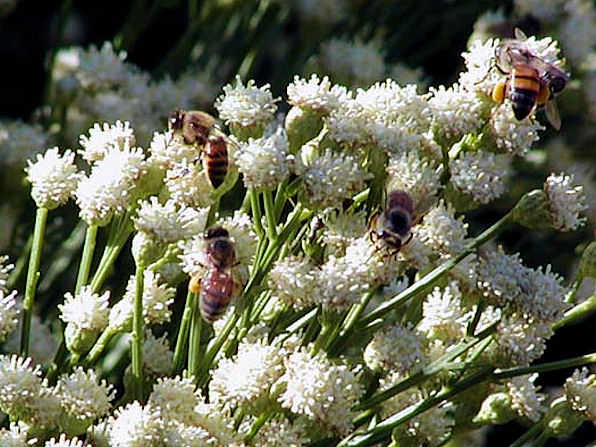Xeriscape Landscaping Plants For The Arizona Desert Environment.
Pictures, Photos, Information, Descriptions,
Images, & Reviews.
Groundcovers.
Trailing Desert Broom, Baccharis Thompson™ ('Starn').
We Are Proud Of Our SafeSurf Rating!
Click On Any Of The Following Links By Amazon.Com
For Books, & Videos About Wildflowers Of Arizona & The Southwest USA. No Obligation!
 |
| Trailing Desert Broom, Baccharis 'Centennial'. With Gentle Italian Honey Bees. Apis mellifera ligustica. All Photos Courtesy: Wikipedia, the free encyclopedia. |
|---|
 |  |
| Trailing Desert Broom. Baccharis 'Centennial'. With Gentle Italian Honey Bee. Apis mellifera ligustica. With Pollen. | Note: No Flowers. Trailing Desert Broom. Baccharis Thompson™ ('Starn'). |
|---|
 /
/

Trailing Desert Broom.
We wish to thank Wikipedia, the free encyclopedia for some of the information on this page. We share images and information with Wikipedia. The NATIVE species of Desert broom is a vertical, evergreen, densely-branched shrub usually 3 to 6 feet tall. Its many fine twigs are green; the tiny, linear leaves are deciduous during dry periods. The plants are dioecious (that is, each individual plant bears only “male”or “female” flowers) and blooms in the fall. The wind- dispersed, white-tasseled seeds are produced by the female plants in such abundance that the plants and nearby ground appear to be snow-covered. THE LITTER OF SUCH FLOWERING MAKES THE PLANT UNDESIRABLE AS A LANDSCAPING PLANT. BUT, WE ARE IN LUCK! HYBRIDS HAVE BEEN DEVELOPED. One of the first to be introduced for use in low-desert landscapes was developed by Dr. Tommy Thompson and Dr. Chi Won Lee of the University of Arizona. Baccharis "Centennial". It is a hybrid between B. pilularis and the desert species, B. sarothroides (desert broom). Although Baccharis "Centennial" is a commonly planted hybrid cultivar, it is a female cultivar, and it produces a lot of cotton looking seed clusters that are very messy. Dr. Tommy Thompson, and Dr. Chi Won Lee's research has been carried onward, and now the improved Thompson™ clone is available. The similar 'Starn' cultivar is a male which does not produce the numerous flowers and seeds making it a better choice. Also, Thompson™ was selected from the next generation after 'Centennial', and has 25% more Baccharis sarothroides for heat and disease resistance. The growth habits and uses of these two clones are essentially the same: both grow to about 3 feet tall by 4 - 5 feet wide in about ten years of growth. They both are evergreen with bright green foliage and inconspicuous flowers. This provides a low-maintenance, long-lived alternative plant to grow in difficult locations. It has a prostrate growth habit, a tolerance of dry heat and drought. It also provides greener foliage than most other desert plants, and it works well in transition plantings on golf courses, medians, and along roadsides. Baccharis Thompson™ ('Starn') should be pruned in the late fall to manage its size and to remove branches of an upward growth habit. Baccharis Thompson™ ('Starn') also grows well with drip irrigation, which it needs during the hottest parts of summer.
Quick Notes:
Height: Height 2 feet to 3 feet. Width 4 to 5 feet.
Flowers: The color of the male flower bud is cream colored. Found in racemes, displayed in 1/4 inch flowerheads.
Flowering Time: Mid October - January.
Fruit: Baccharis seeds are small achenes tipped with long feathery white threads. They of course, would only be on female Baccharis. Not Baccharis Thompson™ ('Starn').
Leaves: Thick, sessile, green, narrowly linear - oblanceolate.
Found: Native to USA.
Hardiness: We have read one report from a gardener in Zone 6a who has grown this plant. The Arizona Municipal Water Users Association says it is hardy to 15 °F.
Soil pH requirements:
Sun Exposure:
Elevation: 500 to 3,900 feet In Arizona.
Habitat: Desert, desert grasslands, and chaparral.
Miscellaneous: An ideal xeriscape landscape plant at low elevations in Arizona. Designed especially for Xeriscape.
|
We Are Proud Of Our SafeSurf Rating!



We Are Proud Of Our SafeSurf Rating!
Click On Any Of The Following Links By Amazon.Com
For Books, & Videos About Xerioscape Plants Of Arizona & The Southwest USA. No Obligation!
Back To Arizona Xeriscape Landscaping Main Page.
Back To Xeriscape Groundcovers Page Three.
Back To Arizona Wild Flowers Home Page
Back To DeLange Home Page
© 1966 - Present, Audrey, Eve, & George DeLange
| © 1966 - Present, Audrey, Eve, & George DeLange |


